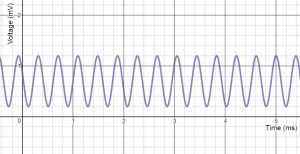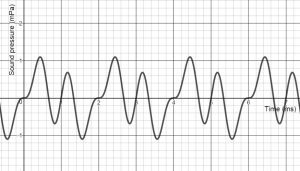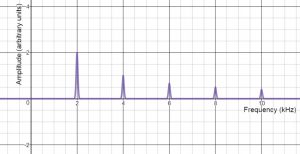Vibrations
7 Vibrations: Review and homework
Important Terms
- vibration
- oscillation
- simple harmonic oscillation
- period
- amplitude
- frequency
- fundamental frequency
- spectral content
- overtone
- time domain graph
- frequency domain graph
Review Questions
- What is a vibration? How is a vibration different than an oscillation?
- List and describe three types of vibrations.
- How are period and frequency related?
- Is it possible for a an object to vibrate at several frequencies at the same time? If so, explain how it’s possible. If not, explain why it’s impossible.
- List common metric units for period, frequency and amplitude.
- Explain the relationship between spectral content, fundamental frequency and overtones.
- What is a time domain graph? How can you produce one?
- What information is shown on a frequency domain graph? What information isn’t?
- Contrast time domain and frequency domain graphs. What are the strengths and weaknesses of each type of graph?
Numericals
- The lowest pitched sound Andre can hear has a fundamental frequency of 90 Hz. How long (in seconds) does it take Andre’s eardrum to move in and out once when he is hearing this sound?
- Shayna can hear sounds that have fundamental frequencies as high as 16,000 Hz. How long (in seconds) does it take her eardrum to go in and out once when she hears this high sound?
- A nurse is measuring the pulse rate of a patient. He counts 81 pulses in a minute. How many seconds are there between her patient’s heartbeats? What is the frequency of the patient’s heartbeat (in Hz)?
- A mass bobbing up and down on the end of spring executes twenty full cycles in 9.3 seconds. What is the period of oscillation? What is the frequency?
- A gear with 25 teeth is spinning at 40 revolutions per minute. A person sticks a card in the moving gear, creating an annoying sound. How often are gear teeth hitting the card? (Express your answer in Hertz).
- Below is a time domain graph showing the voltage produced by a microphone.

-
- Is this a complex vibration? Explain.
- Is this noise? Explain.
- What is the fundamental frequency of this vibration?
- What is the fundamental period of this vibration?
- What is the amplitude of this vibration?
- Below is a time domain graph showing the voltage produced by a microphone.

-
- Is this a complex vibration? Explain.
- Is this noise? Explain.
- What is the fundamental frequency of this vibration?
- What is the fundamental period of this vibration?
- What is the amplitude of this vibration?
- You can make a pitched noise by inserting a piece of paper into a spinning gear. (If you’ve ever put a playing card into the spinning spokes of your bike wheel, you know what I’m talking about). If the gear is spinning fast enough (about 10 times faster than most bike wheels spin), the sound becomes a pitched sound! Suppose you have a gear with 34 teeth that spins at 624 revolutions per minute. What is the fundamental frequency of the card’s vibration?
- Below is a frequency domain graph of the vibration of a microphone.

-
-
- Is this simple harmonic motion? Explain.
- Is this noise? Explain.
- What is the fundamental frequency of this vibration?
- What is the fundamental period of this vibration?
- List two overtones of this vibration.
- Which vibration occurred first: the 4 kHz vibration, or the 6 kHz vibration? (Hint: Is it possible to tell?)
-
Explorations
- Play with a tuning fork. Touch various parts of the fork to the hairs on your arm and/or a piece of paper. Try to figure out which parts are vibrating with least/most amplitude. Try to figure out which direction the different parts are moving. (Hint: vary the relative orientation of the tuning fork and the paper).
- Set up a mass bobbing up and down on a spring. Learn to measure the period accurately. (Hint: Time multiple cycles, rather than just a single cycle). Test whether changing the amplitude has any effect on the period. Test whether the amount of mass affects the period. Test whether changing the spring has any effect on the period. Keep in mind that when you test one variable, you need to keep all the other variables constant.
- Use Audacity and a microphone to record and analyze various sounds. Audacity is a free application for recording, generating and analyzing audio signals, available at https://www.audacityteam.org/download/. The program is available for Mac, PC and Linux. Some sounds to try: a tuning fork mounted to a box*, the sound from a music instrument tuner, your voice (especially if you can sing a clear tone). Audacity automatically produces time domain graphs and can be used to generate spectrum plots, too. (* A bare tuning fork usually does not provide enough sound to make a decent recording).
- Explore the relationship between time domain and frequency domain graphs using PhET’s Making Waves Java app at https://phet.colorado.edu/en/simulation/legacy/fourier. This app allows you to set the height of different “spikes” on a frequency domain graph (bar chart, actually) and see the effects on the time domain graph. You may find it helpful to collapse/hide the middle panel and zoom out on the time axis on the bottom panel.
Image credits
- Time domain graph for a microphone. Created by Abbott using desmos.com
- Time domain graph for a microphone. (2) Created by Abbott using desmos.com
- Frequency domain of a microphone’s vibration. Created by Abbott using desmos.com
